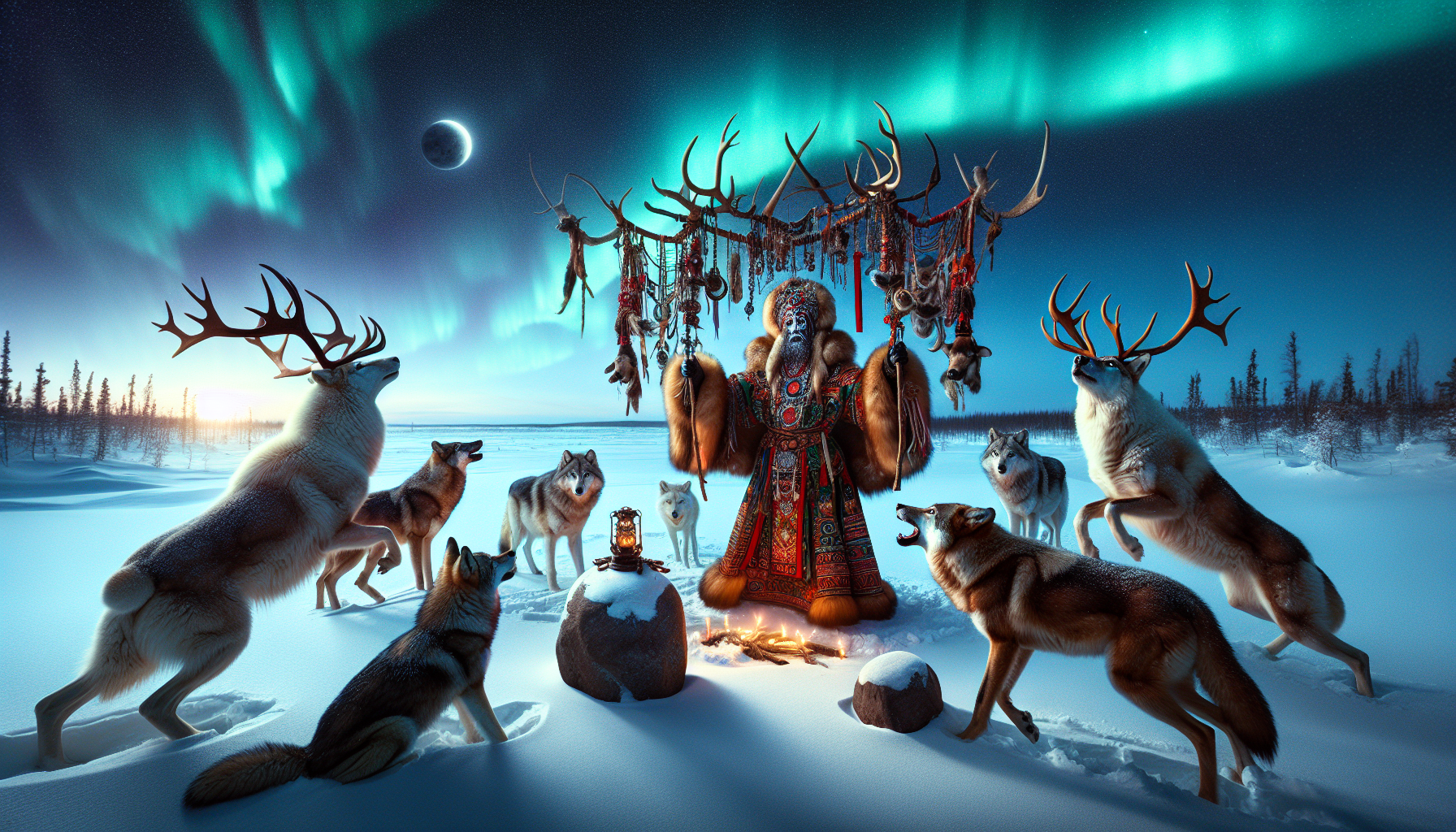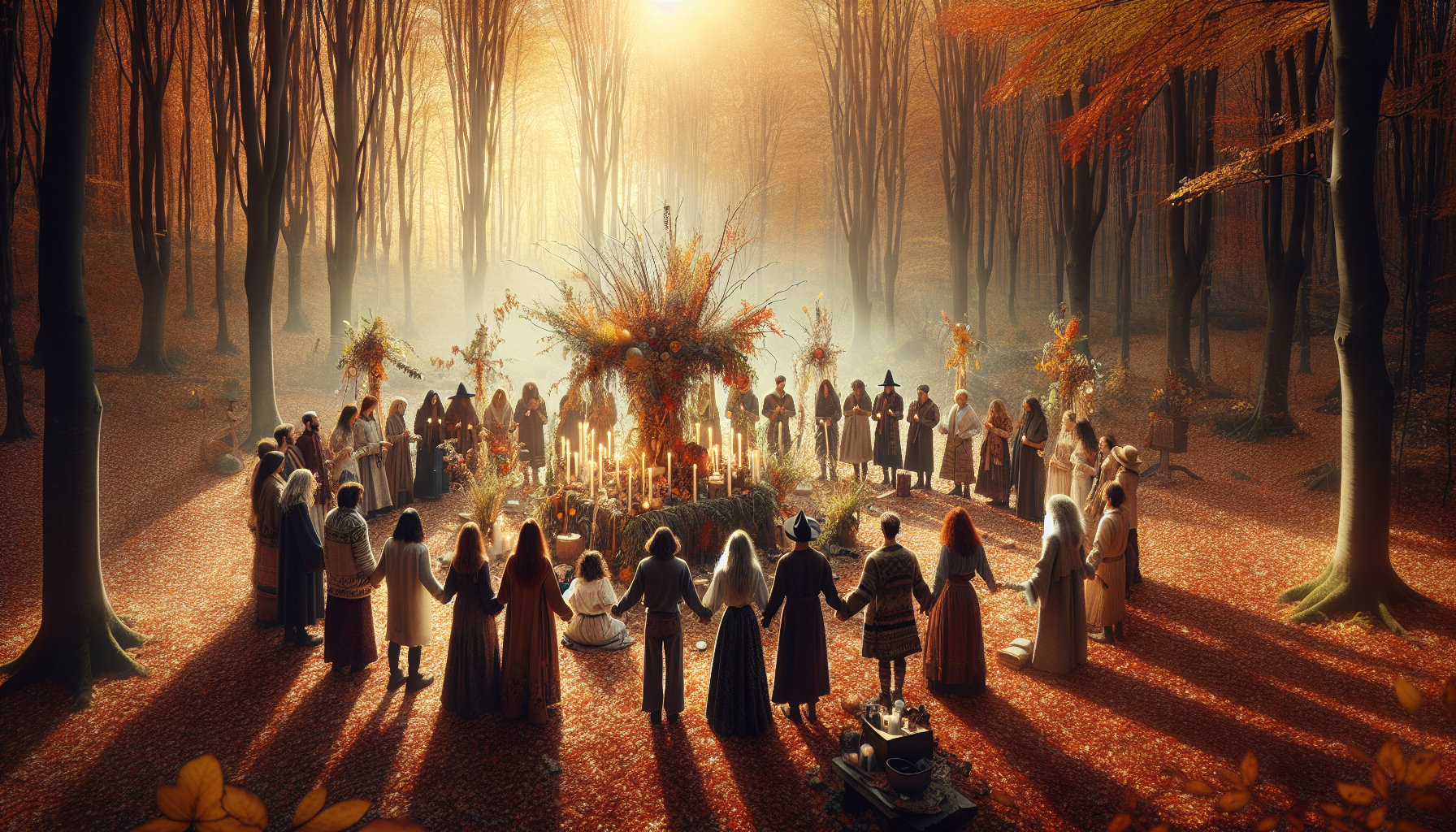In the vast, icy expanse of the Siberian tundra, where the horizon stretches endlessly and the Northern Lights dance with ethereal grace, an ancient tradition continues to thrive, shrouded in mystery and wonder. This is a world where nature reigns supreme, where the biting wind whispers secrets of ages past, and where the spirit of the land comes alive through the mesmerizing practice of shamanic animal dances. These dances are not mere performances; they are profound expressions of spirituality, deeply rooted in the belief that every element of nature is imbued with a living soul. 🌌
Imagine standing on the frozen ground, enveloped by the crisp air, as the rhythmic beat of a drum reverberates through the silence. The shamans, adorned in intricate costumes of fur and feathers, begin to move with a fluidity that seems to transcend human capability. Each dance is a sacred ritual, a bridge between the physical and spiritual realms, meant to invoke the spirits of the animals they emulate. The shaman becomes the bear, the wolf, or the eagle, channeling their strength, wisdom, and keen instincts. These performances serve as a powerful reminder of the interconnectedness of all life and the reverence the Siberian peoples have for the natural world. 🐺
In this article, we will embark on an enlightening journey into the heart of Siberian shamanic practices, exploring the significance and symbolism of these mystical animal dances. We will delve into the history of Siberian shamanism, tracing its roots back thousands of years to understand how these traditions have endured and evolved. Furthermore, we will examine the role of the shaman in Siberian society, not only as a spiritual leader but as a healer, mediator, and keeper of ancestral knowledge. Through captivating stories and firsthand accounts, we will uncover the teachings embedded within these dances and their profound impact on both participants and observers.
As we peel back the layers of this enigmatic world, you will gain insights into the rich tapestry of myths and legends that underpin these rituals. Discover how the shaman’s connection with animal spirits guides their community through times of hardship and prosperity. Whether you are a spiritual seeker, a lover of cultural traditions, or simply curious about the world beyond your doorstep, this exploration of Siberian shamanic secrets promises to inspire and enlighten. So, wrap yourself in a warm blanket, let the imagery of the tundra envelop your imagination, and prepare to be captivated by the mystical animal dances of Siberia. 🦅
The Mystical Roots of Siberian Shamanism
Siberian shamanism is one of the most enigmatic and profound spiritual traditions known to humanity. Deeply rooted in the icy expanse of the tundra, these practices have been passed down through generations, maintaining a connection with the earth and the spirits that inhabit it. The Siberian landscape, with its harsh climate and breathtaking beauty, has shaped the worldview of its native peoples, leading to a rich tapestry of spiritual beliefs and rituals.
Shamanism in Siberia is not just a religion but a way of life. It is an intricate system where the spiritual and the physical worlds intertwine seamlessly. The shamans, considered the bridge between these two realms, play a crucial role in maintaining the balance of the community. They are healers, storytellers, and guides, often entering trance states to communicate with spirits, seeking guidance or healing for those in need. These trances are sometimes induced by rhythmic drumming or the ingestion of sacred plants, which helps the shaman to transcend the ordinary world and access spiritual insights.
Central to Siberian shamanism is the belief in animism—the idea that everything, from animals to rocks, possesses a spirit. This belief is reflected in their rituals, which often involve dance, music, and symbolic representations of animals. The dances, in particular, are a vital aspect of their spiritual practice. These mystical animal dances are more than just performances; they are a form of communion with the spiritual world, allowing shamans to channel the energy and wisdom of the animals they mimic.
The Symbolism and Significance of Animal Dances
Animal dances in Siberian shamanism are rich with symbolism, each movement and gesture imbued with meaning. These dances are not mere imitations of animal behavior but are considered a sacred art form that connects the physical world with the spiritual realm. Through these dances, shamans embody the spirits of animals, tapping into their power and wisdom to bring healing and insight to their communities.
Each animal in the shamanic tradition holds specific symbolic significance. The bear, for example, is revered for its strength and protective qualities, often associated with healing and medicine. During a bear dance, a shaman may enter a trance-like state, embodying the bear’s spirit to channel its healing power. Similarly, the eagle, known for its keen sight and ability to soar high above, symbolizes vision and insight. An eagle dance might involve movements that mimic the bird’s flight, allowing the shaman to gain perspective on a situation from a higher vantage point.
The complexity of these dances is often heightened by the use of costumes and masks, which help the shamans to fully transform into the animal spirits they are invoking. The creation of these costumes is a sacred task, often involving the use of natural materials such as feathers, fur, and bones, each selected for its symbolic and energetic properties. This transformation is not just physical but also spiritual, allowing the shaman to transcend the human experience and enter the realm of the divine.
Table: Symbolic Significance of Common Animals in Siberian Shamanism
| Animal | Symbolism | Role in Shamanic Rituals |
|---|---|---|
| Bear | Strength, Healing | Protection and medical rituals |
| Eagle | Vision, Insight | Guidance and perspective |
| Wolf | Community, Intelligence | Teamwork and strategy |
| Deer | Gentleness, Sensitivity | Peace and harmony |
For a deeper understanding of these mystical dances, watch this captivating video by Shamans of Siberia that explores the intricate movements and the profound meanings behind them: Watch on YouTube.
The Role of the Shaman in Community and Healing
The shaman’s role in Siberian communities extends beyond spiritual guidance; they are central figures in the social and healing fabric of their society. Traditionally, shamans are seen as intermediaries between the human world and the spiritual realm. This intermediary role is vital, especially in times of crisis or illness, when a shaman’s ability to communicate with spirits can bring healing and resolution.
Shamans employ a range of methods to diagnose and treat illnesses. These methods often include trance-induced journeys, where the shaman seeks guidance from spirit helpers or ancestors. Such journeys are personal and unique, often involving animal dances to channel the energies required for healing. The belief is that by embodying the spirit of an animal, the shaman can draw upon its strengths to combat physical or spiritual ailments affecting the community.
In addition to healing, shamans are also responsible for the cultural continuity of their communities. They are custodians of myths, legends, and the collective wisdom of their people, passed down through generations. This role is crucial in maintaining the identity and cohesion of the community, especially in the face of external influences that threaten their traditional way of life.
The Challenges of Preserving Shamanic Traditions
Despite its rich history, Siberian shamanism faces significant challenges in the modern world. The pressures of globalization, industrialization, and political changes have all impacted the traditional ways of life for many Siberian communities. Younger generations are often drawn away from traditional practices by the allure of modern urban lifestyles, leading to a decline in the number of practicing shamans.
Efforts to preserve these traditions are ongoing, with many shamans actively working to document and teach their practices to younger generations. This preservation work is crucial, not only for the survival of shamanic practices but also for the cultural identity of Siberian peoples. By keeping the traditions alive, shamans are also preserving the unique wisdom and worldview that these ancient practices offer.
- Engage with the community to learn more about their practices.
- Support initiatives that aim to preserve indigenous cultures.
- Participate in cultural exchange programs to gain firsthand experience.
As you explore the depths of Siberian shamanism, consider how these ancient practices resonate with contemporary issues of spirituality, identity, and community. The mystical dances of the tundra are more than just a glimpse into a different world; they are a testament to the enduring power of human connection with the earth and the spirit world.🌍✨

Conclusion
Certainly! Here’s a detailed conclusion for your article:
—
In conclusion, the exploration of Siberian Shamanic Secrets and the mystical animal dances of the tundra unveils a fascinating intersection of culture, spirituality, and nature that has endured through centuries. This article journeyed through the rich tapestry of Siberian shamanism, highlighting its profound connection with the natural world and the spiritual realm. The intricate dances, often centered around animals, are not mere performances but sacred rituals that embody the symbiotic relationship between humans and the environment.
Firstly, we delved into the historical context of Siberian shamanism, understanding its origins and how it has been preserved through oral traditions and community practices. This cultural heritage is a testament to the resilience and adaptability of indigenous Siberian tribes, who have managed to keep their traditions alive despite external influences and modernization pressures. The shamanic practices serve as a living bridge to their ancestors, fostering a deep sense of identity and continuity.
Next, the article highlighted the significance of animal symbolism in these shamanic rituals. Each dance, whether it mimics the grace of the eagle or the strength of the bear, is a form of communication with the spirit world. These dances are believed to invoke the qualities of the animals they represent, providing healing, guidance, and protection. The shamans, acting as intermediaries, channel these energies, facilitating a dialogue between the tangible and intangible worlds. This unique perspective challenges the often rigid boundaries of contemporary spiritual understanding, offering a holistic approach that integrates mind, body, and spirit.
Furthermore, we examined the role of music and costume in these rituals, emphasizing how they enhance the spiritual experience. The rhythmic beats of drums and the haunting melodies of traditional instruments create an auditory landscape that transcends ordinary consciousness. Costumes, often adorned with feathers, bones, and other natural elements, are not just decorative but serve as powerful symbols of transformation and transcendence.
The importance of preserving these traditions cannot be overstated. In a rapidly globalizing world, where cultural homogenization threatens the uniqueness of indigenous practices, Siberian shamanism stands as a beacon of diversity and depth. By understanding and respecting these ancient rituals, we gain insight into alternative ways of perceiving the world and our place within it. This knowledge is invaluable, especially in addressing contemporary challenges such as environmental degradation and the loss of cultural heritage.
As we wrap up this exploration of Siberian Shamanic Secrets, it is crucial to reflect on the broader implications of these mystical practices. They remind us of the interconnectedness of all living beings and the importance of maintaining harmony with nature. In a time where ecological balance is more critical than ever, the teachings of Siberian shamans offer a timeless perspective that could guide us towards a more sustainable future.
We encourage you, dear reader, to delve deeper into this captivating subject. Whether it be through further reading, engaging with indigenous communities, or simply reflecting on the lessons learned, there is much to gain from embracing the wisdom of the Siberian tundra. Share this knowledge with others, fostering a community of awareness and appreciation for the diversity of human spirituality. 🌍✨
For further research, consider exploring resources such as the Siberian Shamanism section in the Encyclopaedia Britannica (https://www.britannica.com/topic/shamanism/Siberia), which provides an in-depth look at the cultural and historical aspects of these practices. Additionally, the work of anthropologist Piers Vitebsky offers valuable insights into the lives and beliefs of Siberian shamans (https://www.theguardian.com/profile/piersvitebsky).
We invite you to comment with your thoughts and insights below. Your engagement helps create a dialogue that can lead to greater understanding and appreciation of this remarkable cultural heritage. Together, let’s celebrate the richness of Siberian shamanism and ensure its legacy continues to inspire future generations.
—
Gabriel is a visual storyteller and symbolic naturalist whose creations explore the veiled ecologies and ancestral ties between humans and the living world, as echoed through myth and memory. With a sensitivity attuned to the sacred, Gabriel unveils the ancient choreography of plant, animal, and spirit — a realm where forests spoke in signs, rivers kept secrets, and every flower bore a forgotten name.
His path winds through the esoteric — tracing the rituals of forest sages, the herbal codes of ancestral healers, and the silent agreements that once guided human life in deep reciprocity with nature. From moss-covered shrines to twilight groves, Gabriel’s work reveals relationships once vital, now buried beneath layers of modern detachment.
With a foundation in visual design and the aesthetics of ancestral wisdom, Gabriel weaves storytelling into sacred ecology. His work doesn’t just depict — it channels. Drawing from myth, mysticism, and lost herbal traditions, he crafts images and narratives that pulse with the old knowing: that nature is not scenery, but kin and teacher.
Through collections of symbolic visuals, myth-rooted studies, and intuitive reflections, Gabriel invites others to rekindle forgotten senses — to listen not only with ears, but with intuition, memory, and reverence.
His work is a tribute to:
-
The mythic language of trees, stones, and roots
-
Forgotten pacts between healers and the wild
-
The sacred intelligence in nature’s unseen patterns
Whether you walk with the lore of plants, dream with the rhythms of the earth, or simply feel the call of something older in the wind through the leaves, Gabriel welcomes you into a space where symbolism, spirit, and wild nature entwine — one myth, one leaf, one vision at a time.





